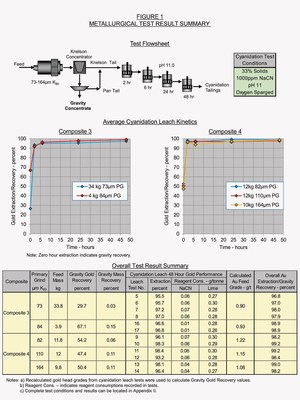|
09.10.2017 08:00:00
|
Landore Resources Limited - Preliminary Assessment of Two Additional Metallurgical Composites BAM East Gold Prospect Junior Lake Property
(AIM Ticker: LND.L)
LONDON, UK, Oct. 9 2017 /CNW/ - Landore Resources Limited (AIM:LND) ("Landore Resources" or "the Company") is pleased to provide a report on the Preliminary Assessment of two additional metallurgical composites from the BAM East Gold Deposit mineralisation on its Junior Lake Property, Ontario, Canada ("BAM East Gold Deposit").
Preliminary Assessment of Metallurgical Composites No's 3 and 4 from within the Inferred section of the BAM East Gold Deposit:
Highlights:
- Combined gold recovery by gravity concentration followed by cyanidation leach extraction of the gravity tail averaged between 97 and 99 percent for both composites tested.
- Leach kinetics were rapid with most of the gold extraction completed within 2 to 6 hours. Both composites recorded very low reagent consumptions: sodium cyanide at less than 0.1 kg/tonne feed, with lime consumptions approximately 0.3 kg/tonne feed.
Drill core material, in the form of two composites weighing a total of 74 kilograms, was submitted to ALS Metallurgy of Kamloops, British Columbia for Gravity Concentration and Cyanidation Bottle Roll leach testing on the gravity tails.
This assessment follows previous testing on composites 1 and 2 (reported in Landore's press release dated January 23 2017) designed to assess the metallurgical response of the mineralised samples from the BAM East Gold Deposit and to provide a determination of the gold feed grade.
Commenting on this report, Chief Executive Officer of Landore Resources, Bill Humphries, said:
"These exceptional results showing up to 99% recovery of gold using a simple combined gravity/leaching process, further enhances the exciting BAM East Gold Deposit and supports our high expectations that it can be developed with low capex/opex costs amongst the lowest quartile of gold mining producers."
Extracts from the report include:
"4.0 Conclusions and Recommendations
Two composites from Landore's BAM East Gold deposit were tested using gravity and cyanidation leach techniques. The composites were formed from half drill core segments and were designated Composite 3 and 4.
Measurement of the gold feed content was completed using duplicate screened metallic assays. Composites 3 and 4 measured about 0.5 and 1.0 g/tonne gold respectively.

Metallurgical performance was excellent for both tested composites. Composite 4 was tested at primary grind sizings between 82 and 164µm K80. Combined gravity gold recovery and cyanidation leach gold extractions for Composite 4 also measured about 97 to 99 percent of feed gold. A coarser primary grind sizing of 162µm K80 did not appear to have negative effects on overall gold extraction/recovery.
Combined gravity gold recovery and cyanidation leach gold extractions for Composite 3 was also very high, and measured between 97 to 99 percent of feed gold. Initial gravity separation testing with 34 kilograms recorded a recovery of the feed gold to a pan concentrate of about 30 percent, lower than that recorded for Composite 4 and Composites 1 and 2 in previous test work. A repeat gravity concentration test with 4 kilograms resulted in a gold gravity recovery of 67 percent, but at a mass recovery 5 times higher than the initial test. Gravity gold recovery appeared to be quite susceptible to mass recovery to the pan concentrate for this composite. Calculated gold feed grades were about 0.9 and 1.2 g/tonne for Composites 3 and 4, respectively, and would be considered a more representative feed grades than the screen metallic assays due to the much larger mass utilized.
Reagent consumptions recorded in the cyanidation leach tests were very low for both composites; sodium cyanide consumptions were below 0.1 kg/tonne, and lime consumptions averaged about 0.3 kg/tonne.
Results indicate that a combination of gravity concentration followed by cyanidation leaching of the gravity tails would be an effective flowsheet for the composites tested. A gravity recoverable gold (GRG) test performed iteratively over grind sizings between 750 – 250 – 75µm K80, with assaying for gold by size fraction at each stage, should be considered to better establish gravity gold recovery for the flowsheet.
As results were exceptional over the range of primary grind sizings tested, testing using coarser feed sizings are recommended in future test programs. Future testing should also consider column leach testing with crushed feed to investigate gold extraction through heap leaching. Test results would provide information that could be used for trade-off studies comparing overall gold recovery at reduced comminution capital and operating expenses."
End of Extracts
The full report with results has been posted on Landore Resources's Web site
Planned Works:
Additional metallurgical testing for inclusion into Pre-Feasibility study will be completed in the first half of 2018.
Michele Tuomi, (P.Geo., BSc. Geology), Director/VP Exploration of Landore Resources Canada Inc. and a Qualified Person as defined in the Canadian National Instrument 43-101 and the AIM Rules for Companies, has reviewed and verified all scientific or technical mining disclosure contained in this announcement.
About Landore Resources
Landore Resources is an exploration company that seeks to grow shareholder value through the acquisition, exploration and development of precious and base metal projects in eastern Canada. The Company is primarily focused on the development of the Junior Lake Project. Landore Resources has mineral rights to 5 properties in eastern Canada. The Company is headquartered in Guernsey, with an exploration office located in Thunder Bay, Ontario, Canada.
This announcement contains inside information as defined in Article 7 of the Market Abuse Regulation No 596/2014.
SOURCE Landore Resources Limited
 Der finanzen.at Ratgeber für Aktien!
Der finanzen.at Ratgeber für Aktien!
Wenn Sie mehr über das Thema Aktien erfahren wollen, finden Sie in unserem Ratgeber viele interessante Artikel dazu!
Jetzt informieren!